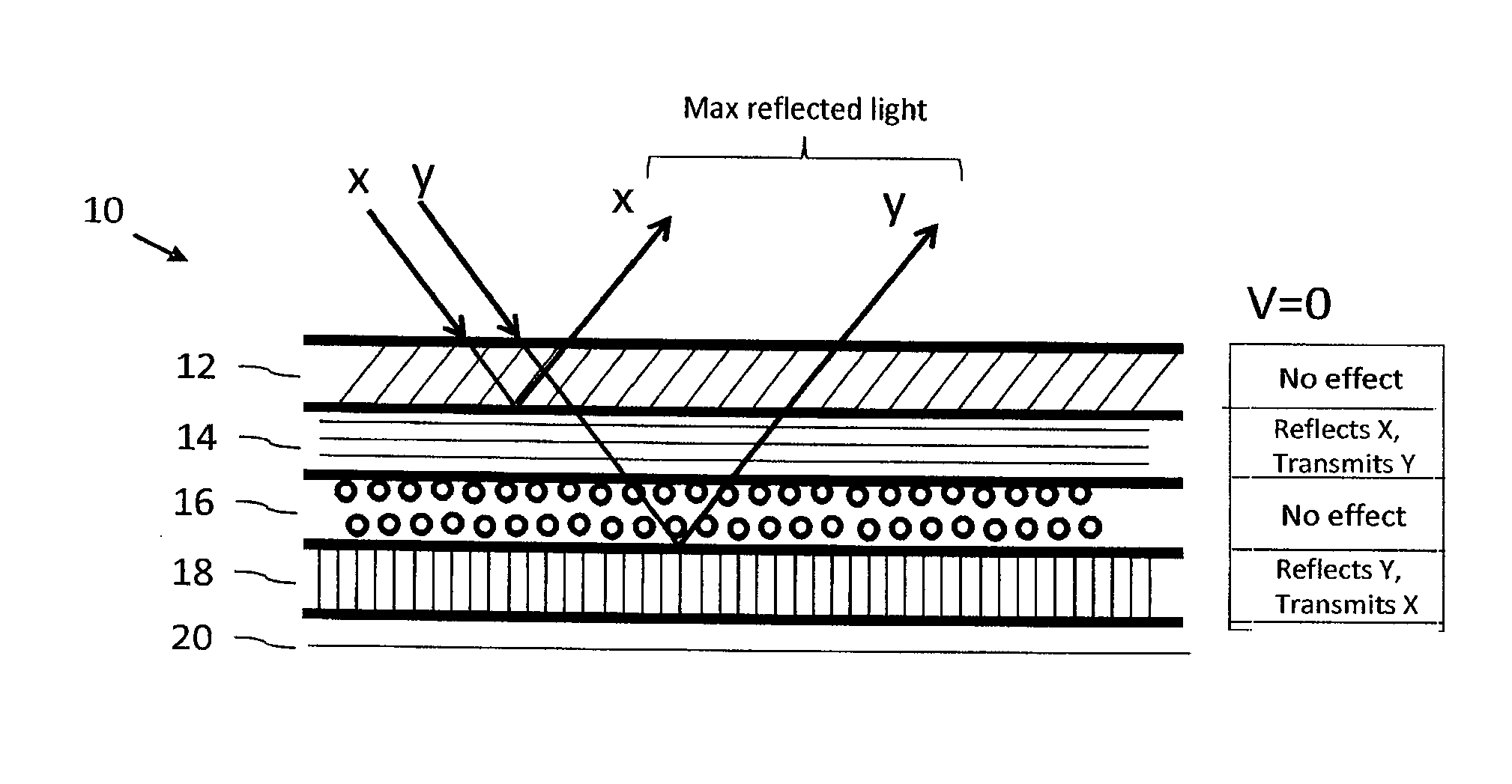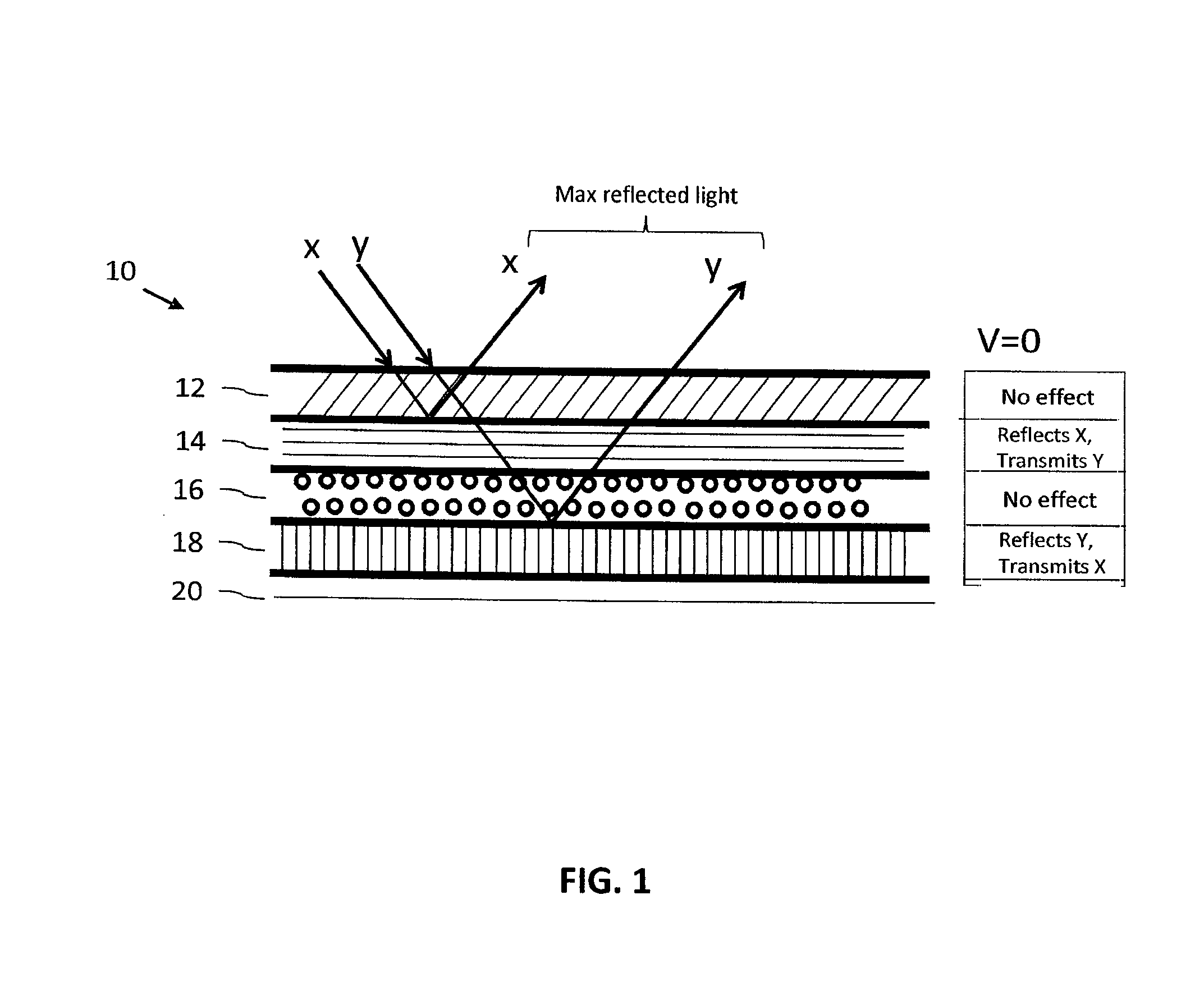Electronically dimmable optical device
a technology of optical devices and reflectors, which is applied in the direction of instruments, polarising elements, vehicle components, etc., can solve the problems of only aggravated, insufficient intensity of reflected headlights from trailing vehicles, and temporarily visual impair or dazzle the operator, so as to achieve the effect of varying the reflectivity of the device and the level of the devi
- Summary
- Abstract
- Description
- Claims
- Application Information
AI Technical Summary
Benefits of technology
Problems solved by technology
Method used
Image
Examples
example 1
[0095]FIGS. 1 and 2 show a first configuration assembly 10, which is designed for a dimming system and comprises of the following layers: an active polarizer 12 with an absorptive axis in the x-direction (when activated) at the viewing surface 13 of the device, adjacent a static reflective polarizer 14 with a reflective axis in the x-direction, adjacent an active polarization rotator 16, adjacent a static reflective polarizer 18 with a reflective axis in the y-direction. It should be noted that the active polarizer and the active polarization rotator may be independently operated.
[0096]FIG. 1 and Table 1 show the device functioning in an OFF (V=0 or voltage-off) state. Unpolarized light 30 with both x and y polarizations is incident on the first active absorptive polarizer 12 oriented in the x-direction. With no voltage applied, the active absorptive polarizer 12 will have minimal effect on the incident polarizations. Therefore, both polarizations will predominantly pass through to ...
example 2
[0102]In another embodiment, shown in FIGS. 3 and 4, a second configuration designed for a dimming system is shown. The system 50 includes: an active polarizer 52 with absorptive axis in the x-direction when activated, adjacent a first static reflective polarizer 54 with a reflective axis in the x-direction, adjacent an active polarization rotator 56, followed by a second static reflective polarizer 58 with reflective axis in the x-direction. It should be noted that the active polarizer 52 and the active polarization rotator 56 may be independently operated.
[0103]FIG. 3 and Table 3 show the device functioning in an OFF (v-0 or the voltage off) state. Unpolarized light 30 with both x and y polarization is incident on the first (active absorptive polarizer) oriented in the x-direction. With no voltage applied, the active absorptive polarizer 52 will have minimal effect on the incident polarizations. Therefore, both polarizations will predominantly pass through to the next surface. The...
example 3
[0108]FIG. 5 shows a configuration of a mirror device corresponding to the that shown in Example 1 but with the addition of a display device on the non-viewing side of the mirror.
[0109]FIG. 5 shows how when a maximum voltage is applied (Vmax), the x-direction polarized light emitted from the display device 100 will be transmitted through the second static reflective polarizer 18 to the polarization rotator 16, which will rotate the polarization direction of the light to a y-direction. This y-direction light will then pass through the first static reflective polarizer 14 and the active polarizer 12 largely unaffected, to emerge through to the viewing surface 13 of the mirror 10.
[0110]In this configuration, the display light has the same polarization as the polarization axis of the absorptive polarizer.
PUM
 Login to View More
Login to View More Abstract
Description
Claims
Application Information
 Login to View More
Login to View More - R&D
- Intellectual Property
- Life Sciences
- Materials
- Tech Scout
- Unparalleled Data Quality
- Higher Quality Content
- 60% Fewer Hallucinations
Browse by: Latest US Patents, China's latest patents, Technical Efficacy Thesaurus, Application Domain, Technology Topic, Popular Technical Reports.
© 2025 PatSnap. All rights reserved.Legal|Privacy policy|Modern Slavery Act Transparency Statement|Sitemap|About US| Contact US: help@patsnap.com



